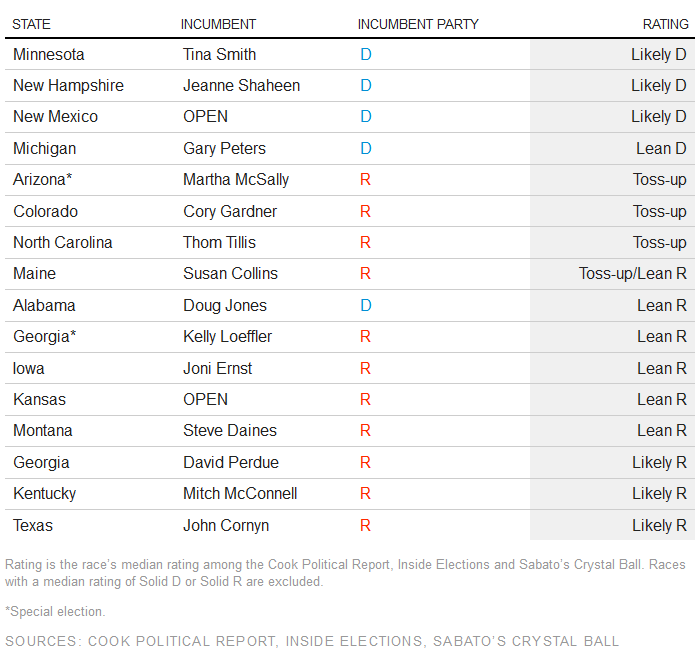Election 2020: Democrats Zeroing in on Four States in Effort to Flip the Senate

With all the Wuhan coronavirus news, leftist powerplays, and shutdown edicts, we haven’t focused as much on the upcoming election. On November 3, we’ll be electing not just a president but also deciding who controls both houses of Congress.
Republicans, obviously, want to keep control of the Senate, while Democrats are eager to win it. The Republican Senate majority stands at 53 to 47, including two Independents who caucus with the Democrats (socialist Vermont Sen. Bernie Sanders and Maine Sen. Angus King).
Therefore, Democrats need to flip four seats, three if they win the White House. While it seems likely that Republicans will keep their majority, it’s by no means certain. Republicans are defending 23 seats, while Democrats are defending only 12.
Fivethirtyeight reported on March 30, 2020:
Republicans started the cycle with the advantage, but Democrats have had reason for optimism of late. New polls have shown Democratic challengers ahead of GOP incumbents, the party is recruiting strong candidates, and, perhaps most importantly given the tight correlation between presidential and Senate voting, former Vice President Joe Biden, the Democrat who has polled the best against President Trump, has become the party’s likely presidential nominee.The most likely outcome is still that Republicans maintain control of the Senate, though perhaps with a reduced majority: The status quo favors them, and most of the states where the Senate will be decided lean red. (As a refresher, Republicans currently have 53 Senate seats to Democrats’ 47,1 meaning Democrats need to flip four seats, on net, to take control — or three if they also win the vice presidency.) But Democrats have expanded the map to the point where they have a lot more pick-up opportunities than Republicans do, so they have a lot of upside.. . . . Competitive U.S. Senate seats up for election in 2020, as rated by three major election handicappers:

With 200 days to go until Election Day, the Democrats’ path to a Senate majority currently hinges on four states: Arizona, Colorado, Maine and North Carolina, where Republican incumbents are fighting off challenges from well-funded Democratic opponents.Democrats need to flip three or four seats, depending on which party wins the White House in November, to take control of the Senate. But one of their incumbents up for reelection this year, Sen. Doug Jones (D-Ala.), is in serious political jeopardy, meaning that Democrats will likely have to take at least four Republican-held seats — and hold back GOP challenges in nearly a dozen other states — to win a majority.. . . . Democrats’ softest target may be in Colorado, where Sen. Cory Gardner (R) is facing changing political headwinds and a challenge from John Hickenlooper, the state’s popular former Democratic governor and the prohibitive front-runner in a crowded primary field.The party is also confident of defeating Sen. Martha McSally (R) in Arizona. McSally already lost a bid against Sen. Kyrsten Sinema (D-Ariz.) in 2018 and took office only after Republican Gov. Doug Ducey appointed her to fill the seat vacated by the late Sen. John McCain (R-Ariz.).And in Maine, Democrats have it out for Sen. Susan Collins (R), a four-term senator whose vote to confirm Supreme Court Justice Brett Kavanaugh in 2017 amid sexual misconduct allegations touched off a flurry of anger from the left. She’s widely expected to face Maine House Speaker Sara Gideon, the Democratic front-runner, in November.Democrats are also looking to oust Sen. Thom Tillis (R) in North Carolina. He’s set to face off against national Democrats’ candidate of choice, Cal Cunningham, in November, and recent polls suggest a tight race.
Not only are Democrats pouring money into these four states with the hope of flipping the Senate, but Republicans are also flooding the states with cash to hang on to their majority.
The Hill continues:
The Senate Leadership Fund, the super PAC aligned with Senate Majority Leader Mitch McConnell (R-Ky.), booked a combined $43.7 million in fall ad reservations across the four battleground states late last month, along with another $32.6 million in Iowa and Kentucky.And just this week, the National Republican Senatorial Committee, invested some $33 million in advertising across seven states: Arizona, Colorado, Iowa, Maine, Michigan, Montana and North Carolina.Meanwhile, Senate Majority PAC, the super PAC aligned with Senate Minority Leader Charles Schumer (D-N.Y.), booked more than $56 million in fall ad reservations across the four key states, plus an additional $13.1 million in fall ad reservations in Iowa.
Democrats are not limiting their sights to these four states, however, and are making plays in Republican-leaning states, as well.
Democrats believe they can also bring a handful of races in more Republican-leaning states into play, including Montana, where Democratic Gov. Steve Bullock is taking on Sen. Steve Daines (R); Texas, where MJ Hegar and state Sen. Royce West are locked in a runoff for the Democratic nomination to challenge Sen. John Cornyn (R); and Kentucky, where Democrat Amy McGrath raised nearly $13 million in the first quarter of 2020 for her bid against McConnell.Democrats also see an opportunity in Georgia, where Sen. Kelly Loeffler (R), who was appointed late last year to fill the seat of retired Sen. Johnny Isakson (R), is facing a challenge from Democrat Raphael Warnock as well as from Rep. Doug Collins (R-Ga.), a steadfast Trump ally who’s running to the right of Loeffler.Those races are likely to prove significantly more challenging for Democrats than the four core races in Arizona, Colorado, Maine and North Carolina, and party operatives are aware that they’ll have to choose their battles carefully as they look to regain the Senate majority.“This isn’t a numbers game. This isn’t the House map,” one Democratic operative familiar with Senate campaigns said. “You’re talking about a very targeted set of races that we need to get back to the majority.”
For President Trump to continue appointing judges and further his agenda should he win a second term, he’ll need at least the Senate. Ideally, he’d win both houses of Congress, and we won’t be subjected to four more years of the Democrat impeachment circus. Including a potentially very different outcome if the Senate is under Democrat control and the Majority Leader is Sen. Chuck Schumer.
CLICK HERE FOR FULL VERSION OF THIS STORY